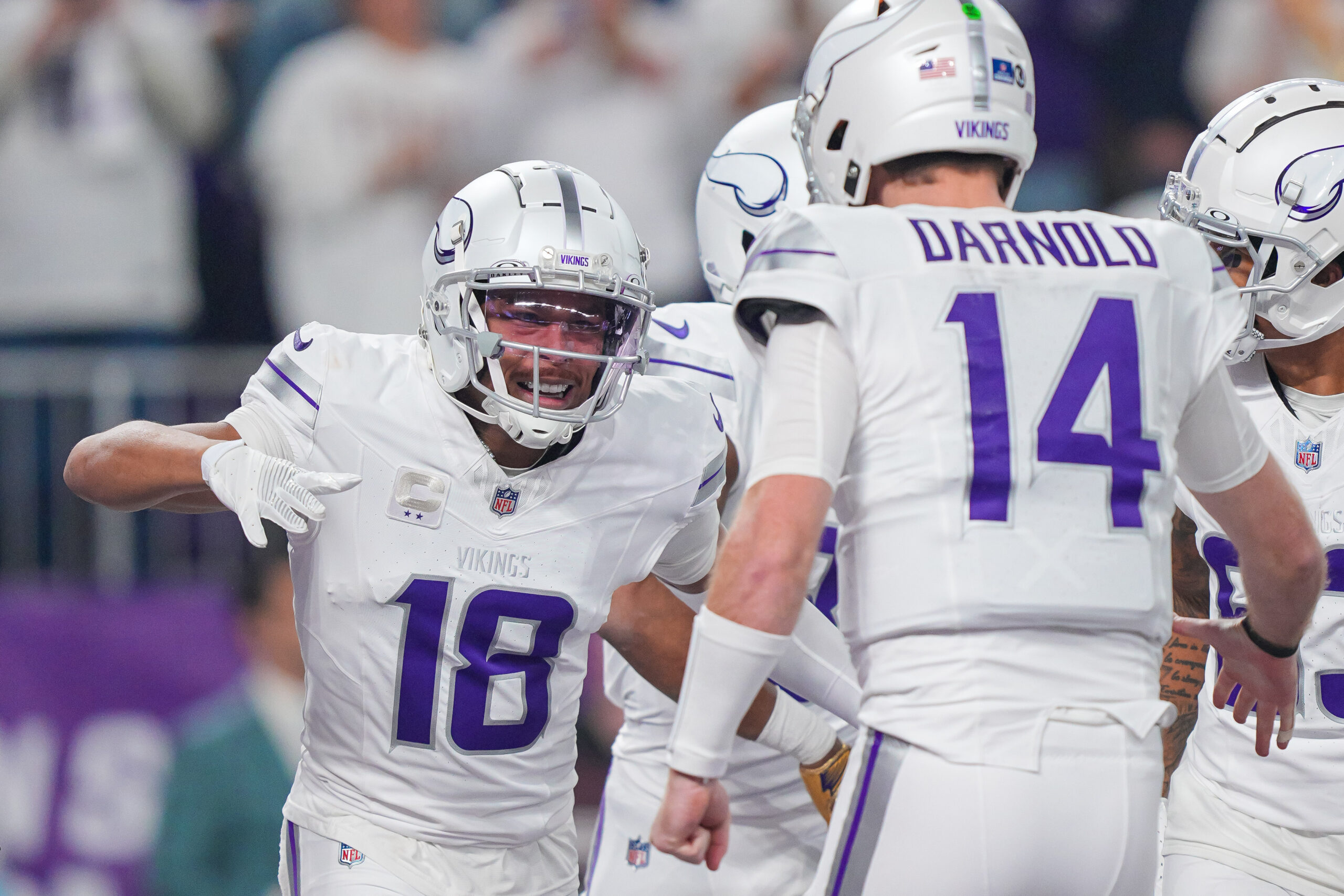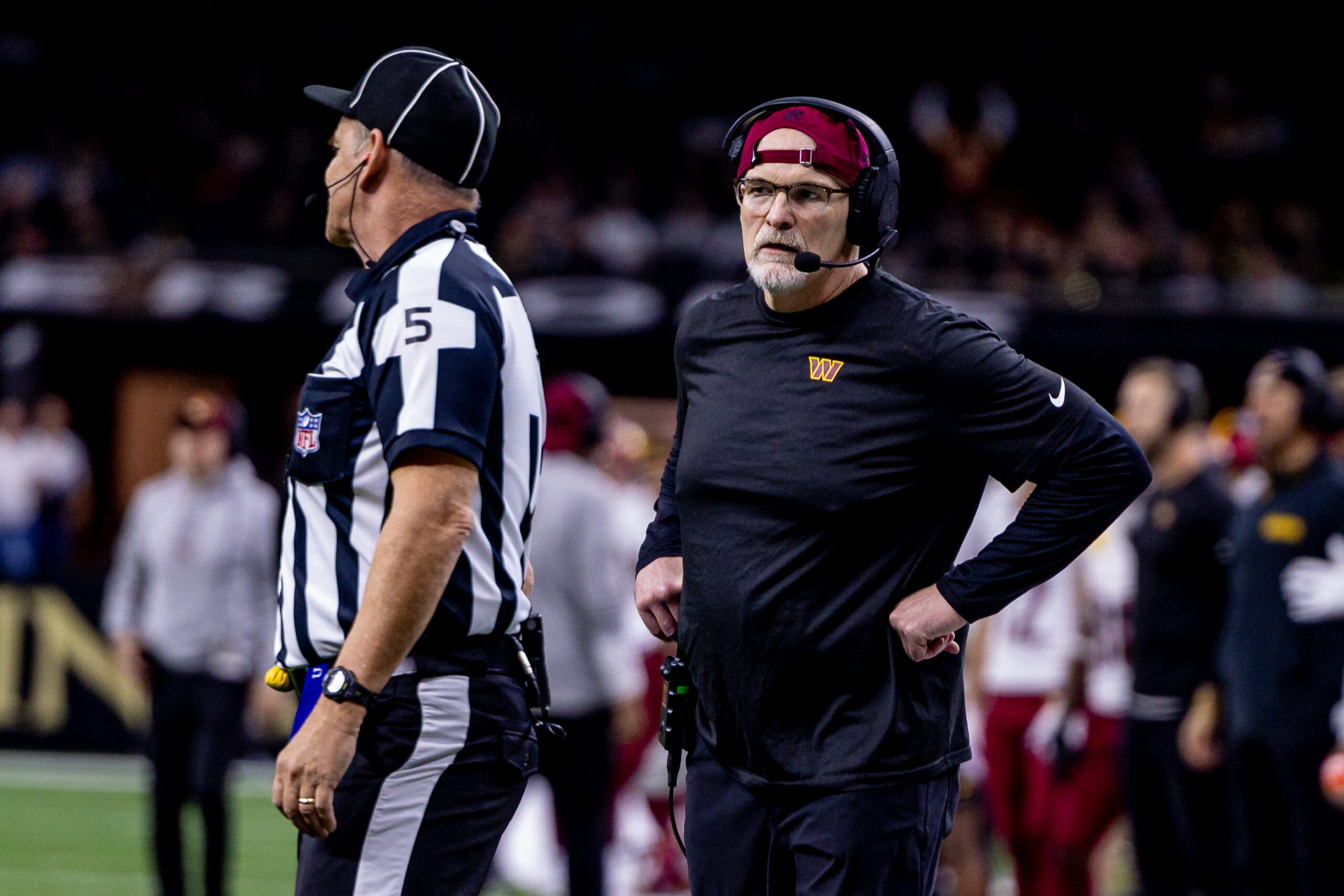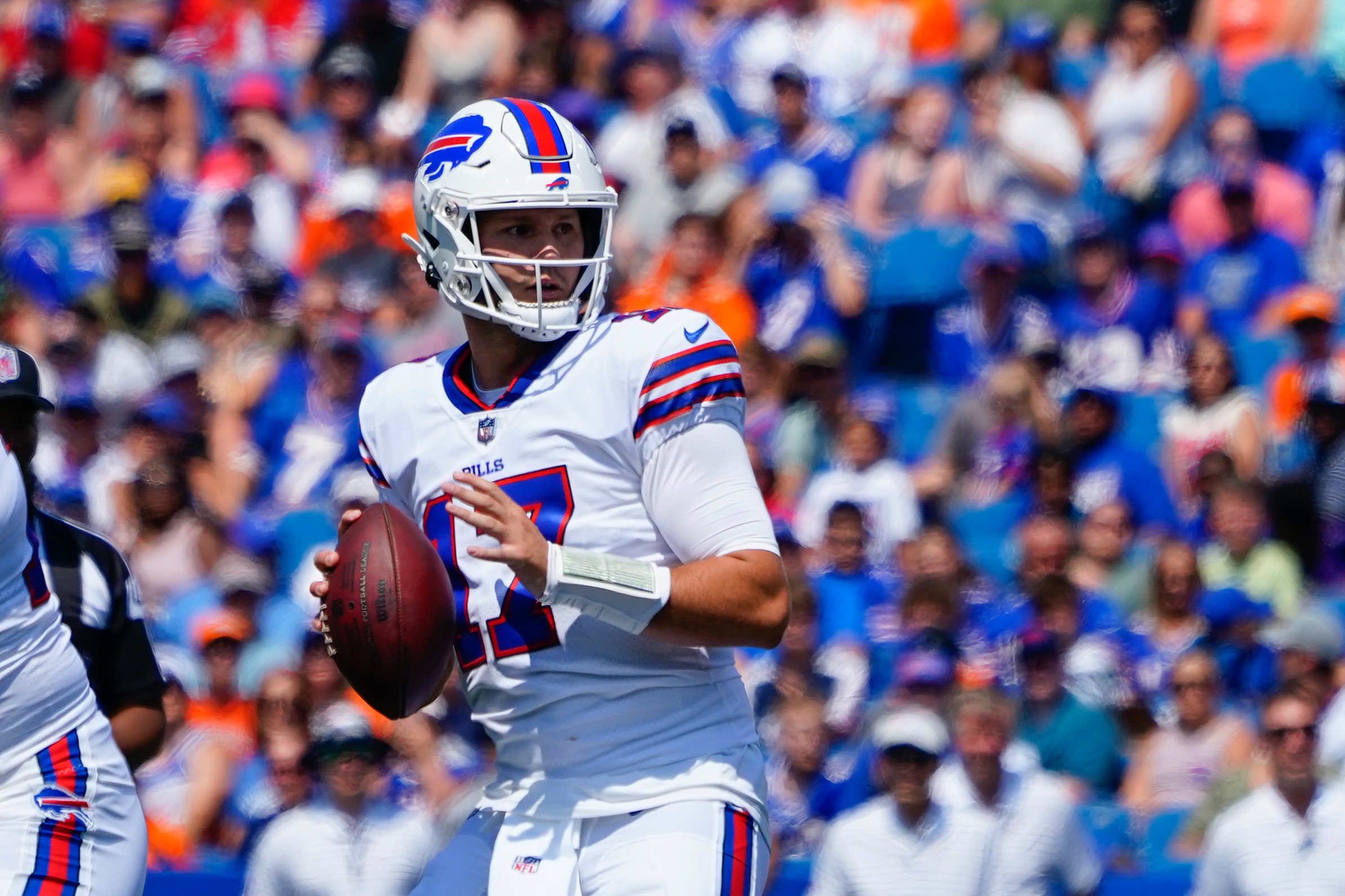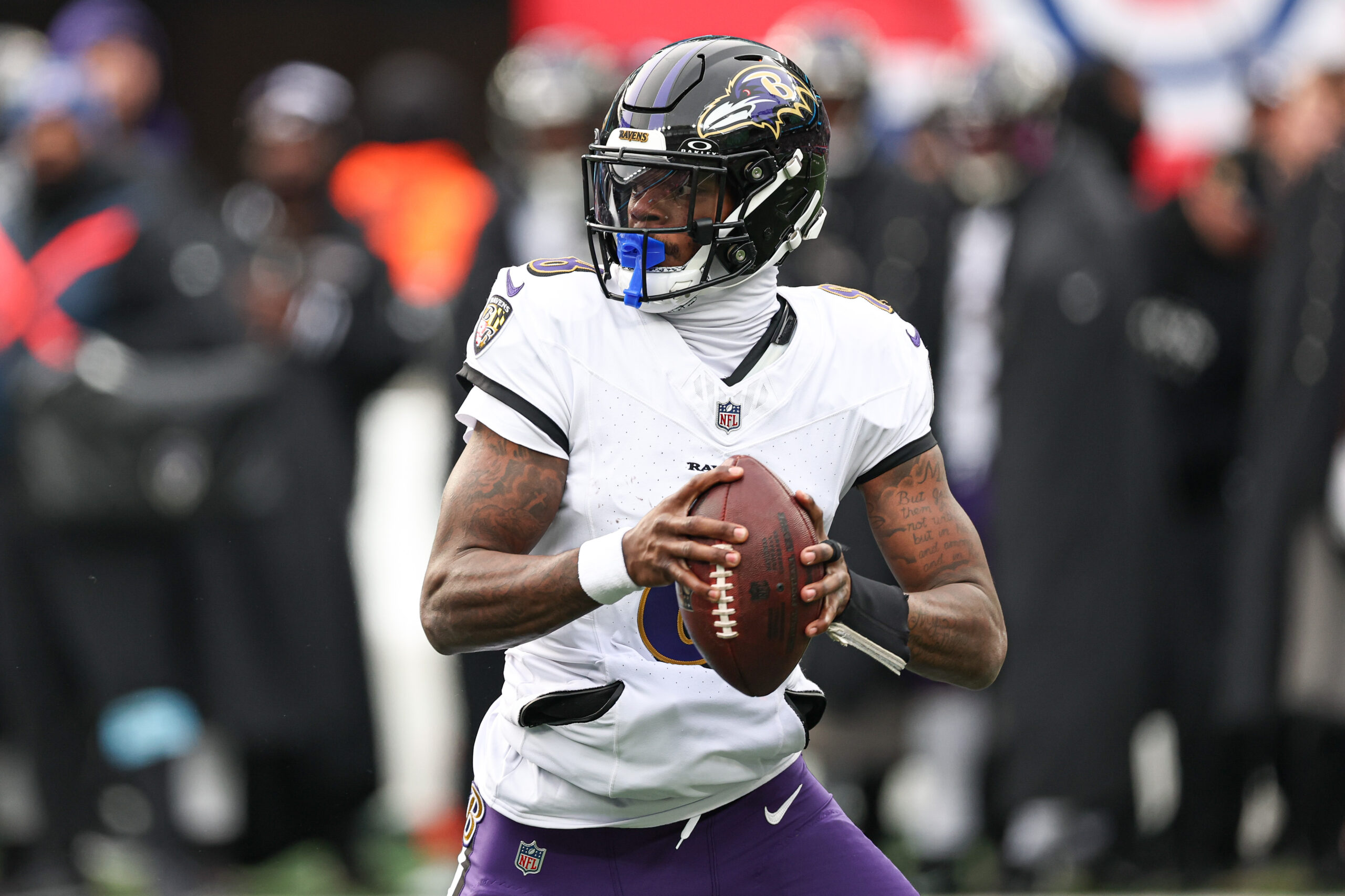NFL Analysis
9/16/24
21 min read
1st & 10: Week 2 - Saints Blowout, Chaotic Vikings, Kyler Murray & More

Welcome to the Week 2 edition of 1st and 10. For those new to this column, we will run down 10 topics each week as a recap of Sunday’s action. We’ll dive deep into the biggest games, stats, and plays from Sunday.
Week 2 is always one of the most exciting weeks because we start to see if what we reacted to in Week 1 was real or just noise. This week was information overload with 10 early games, but we have you covered with what you need to know.
All stats provided by TruMedia unless noted otherwise.
1st & 10 NFL Week 2
1. It’s time to take the Saints seriously
Blowing out the Carolina Panthers might not be all that difficult this season. That’s what the New Orleans Saints did in Week 1. We know historically that blowing out bad opponents is a sign of a good team. However, given the opponent and Week 1, it was easy not to get too caught up in the Saints’ performance.
After a 44-19 win against the Dallas Cowboys in Week 2? The Saints have our attention.
This was a complete win on both sides of the ball. The offense continued to click with confidence from Derek Carr, which allowed big plays to develop down the field.
After throwing a bomb early in the Week 1 win, the Saints came out aggressively against the Cowboys. On New Orleans’s first drive, the Saints had a first-and-10 from the Dallas 44-yard line. The Saints used play-action, which drew the linebackers in. Against a three-deep coverage, Chris Olave ran an over to the vacant middle of the field for a catch-and-run that took the Saints to the 5-yard line and set up an Alvin Kamara touchdown.
— Dan Pizzuta (@DanPizzuta) September 16, 2024
One thing that has helped the Saints is sticking in heavy personnel and using that to keep the defenses in base personnel (the Cowboys were in base 87.5 percent of the time). Plus, they’ve used the tight ends to help in pass protection.
On that Olave catch, the Saints motioned a tight end over to Micah Parsons before the snap. Then, at the snap, another tight end came over. It goes from a double team to passing Parsons off between the two tight ends while keeping the rest of the line free to take on the other four linemen on a five-man front.
Saints using multiple tight ends to block Micah Parsons pic.twitter.com/PyvrgNd589
— Dan Pizzuta (@DanPizzuta) September 16, 2024
Last season, Carr used play-action on a league-low 14.2 percent of his dropbacks. This season, Carr has used play-action on a league-high 50 percent of his dropbacks. Game script has played a big part in that rate being absurdly high thanks to the Saints winning big, but there is a clear focus on using it, along with motion, to create spacing to attack down the field.
Carr is 14-of-20 for 13.2 yards per attempt and 0.53 EPA per play-off play-action through two weeks. Last season, Carr hit his 20th dropback off play-action in Week 5.
He already has half of the deep shots (20 or more air yards) off play-action as he did last season. That includes the 70-yard touchdown throw to Rashid Shaheed that came on New Orleans’s second drive.
In this new offense, Carr has been willing to push the ball down the field. Just 61.5 percent of his throws have traveled 10 air yards or fewer, the third-lowest rate in the league this season.
The Cowboys blitzed on 41.2 percent of Carr’s dropbacks but only had an overall pressure rate of 17.6 percent. Against the Browns last week, the Dallas pass pushers were consistently in the backfield, but the Saints held up in pass protection, even as Carr held onto the ball for an average of 2.71 seconds.
Carr leads the league in EPA per play (0.86) and QBR (96.2).
The Saints also controlled the game on the ground. A weakness for Dallas has been the run defense, and the Saints consistently exploited that.
Kamara had 20 carries for 115 yards with three touchdowns, not including a 57-yard touchdown on a screen in the second quarter. Just five percent of his runs were stopped at or behind the line of scrimmage, the lowest rate in the league this week, and Kamara averaged 2.4 yards before contact per rush.

Through the first two weeks, the Saints have scored a touchdown on 52.4 percent of their drives. The next highest team is at 38.9 percent. A league-low 14.9 percent of their drives have resulted in a punt.
Defensively, the Saints matched the aggression of the offense. Per Next Gen Stats, New Orleans had their corners pressed on 46 percent of snaps, and Dallas receivers drew only three targets when pressed off the line.
Dak Prescott is not afraid to target tight windows, but he threw into a tight window (a yard or fewer of separation when the ball arrives) on 23.1 percent of his attempts, the fifth-highest rate in the league in Week 2. New Orleans had nine passes defended, including two interceptions.
The Saints have a plus-62 point differential. That’s the best start during the first two weeks since the 2019 Patriots had a plus-73 point differential. Just four teams have reached 60 in the first two weeks since 2000. The other three teams all won at least 12 games, but none of them won a playoff game. The 2006 San Diego Chargers made the divisional round, but that was due to a bye.

New Orleans was projected to have one of the league’s easiest schedules, and they’ve already gotten through what was expected to be one of the toughest games. In the next three weeks, the Saints will play the Eagles and Chiefs.
We should take the Saints seriously, but how seriously could depend on that stretch.
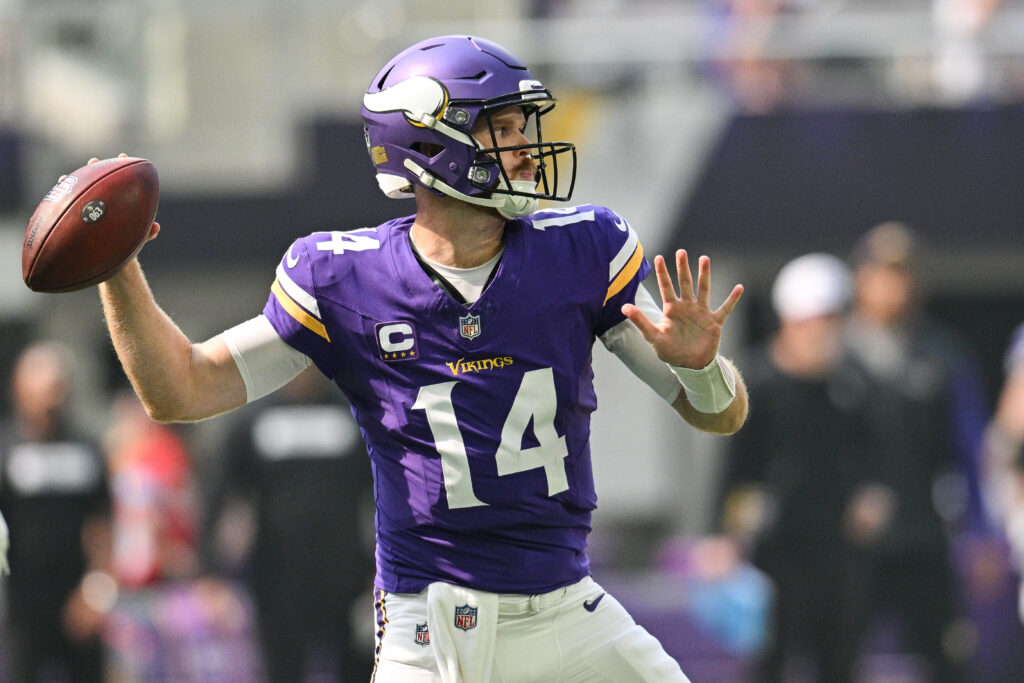
2. The Vikings Are Chaotic Good
The most surprising 2-0 team might be the Minnesota Vikings, who beat the San Francisco 49ers 23-17 with an impressive showing on both sides of the ball.
Sam Darnold did his best peak-Brock Purdy impression. He had a great game with a few impressive throws. He had some wide-open opportunities, as he ultimately finished almost exactly where he should be completion percentage over expectation (-0.1 percent), per Next Gen Stats.
Darnold went 17-of-26 for 263 yards with two touchdowns and an interception for a 62.9 QBR. He picked up 97 of those passing yards on a second-quarter touchdown throw to Justin Jefferson.
— Dan Pizzuta (@DanPizzuta) September 16, 2024
According to Next Gen Stats, Darnold only threw into a tight window on 7.7 percent of his attempts, the sixth-lowest rate of the week. There were open throws all over the offense, including a touchdown pass to Jalen Nailor in the third quarter that was similar to a touchdown the Vikings scored last week against the Giants.
Before the snap, the Vikings motioned TE Josh Oliver to the right side of the line, which brought over a deep safety. Nailor then motioned inside and settled behind Oliver, which brought the safety down toward the line of scrimmage. At the snap, the safety and the corner to that side both took the flat with Oliver, and Nailor was open in the end zone.
— Dan Pizzuta (@DanPizzuta) September 16, 2024
Darnold’s most impressive throw might have been on a third-and-8 up the seam to Nailor. The 26-yard gain kept a drive alive that ended in a field goal and put the Vikings back up by two scores.
This offense has been designed well enough for Darnold to take advantage of some of those openings. As expected, there have been enough big plays to make up for some of the mistakes, such as Fred Warner baiting the quarterback into an interception.
The highlight of this team remains the defense. After not sending a ton of blitzing against Daniel Jones in Week 1, Brian Flores was back to sending the rush against Purdy. Minnesota sent five or more rushers on 45.5 percent of Purdy’s dropbacks.
When Purdy wasn’t blitzed, he averaged 0.35 EPA per play with a 66.7 percent success rate. When he was blitzed, Purdy averaged -0.68 EPA per play with a 30 percent success rate.

Some of those blitzes weren’t traditional “blitzes,” as was the case with the Vikings last season. Minnesota will often show a five-man front and rush all five players. They took down Purdy on a third-and-11 early in the third quarter doing just that. Of course, even that isn’t just a straight five-man rush.
Andrew Van Ginkel stunts to the inside, and his pressure pushes Purdy back into Pat Jones II, who was driving through Trent Williams on the edge.
— Dan Pizzuta (@DanPizzuta) September 16, 2024
Purdy’s eight hits and six sacks were both career highs.
The pressure pushed Purdy off his game and forced him to throw into traffic. Purdy threw into a tight window on 25 percent of his pass attempts, a high figure for a Shanahan offense built on creating and manipulating space. (However, he finished at 24.1 percent in Week 1.)
This was a game when Christian McCaffrey could have helped. Last season, McCaffrey led the 49ers in target share when Purdy was pressured (20.5 percent). Without a receiving threat out of the backfield, the Vikings crowded the middle of the field on those dropbacks, and that’s how Blake Cashman ended up with 15 tackles and three passes defended.
The Vikings represent a uniquely chaotic opponent for the 49ers, but this won’t be the last time San Francisco is tested with pressure while McCaffrey is out.
Minnesota forced Purdy into unwinnable situations, and the defense capitalized on mistakes. That was the biggest difference in this game.

3. Kyler Murray Is Playing Like A top-10 quarterback
That’s where Kyler Murray landed in our latest quarterback rankings, but he’s really played the part during the past two weeks. Murray is second in QBR (91.2) and EPA per play (0.37) after he tore up the Los Angeles Rams in a 41-10 win.
Following the Week 1 concern regarding the involvement of Marvin Harrsion Jr., who was often bracketed with a safety over top against the Bills, the Cardinals got him involved early.
Murray went back to him on a crossing route that turned up the sideline when the quarterback left the pocket.
In the first quarter, Harrison Jr. had four catches for 130 yards and two touchdowns. He did not record a catch after the first quarter, but it wasn’t necessary.
It was great to see the Cardinals get Harrison involved, but it was more exciting to see how they did it. The first Harrison touchdown came in 13 personnel, with Harrison as the only receiver on the field. TE Tip Reiman (87) was lined up out wide to the opposite side.

The second touchdown was also in 13 personnel, with all three tight ends tight to the line.

Arizona used 13 personnel on 22.6 percent of plays against the Rams.
The structure of the Arizona offense was fun, but Murray also made a handful of wild plays on his own. He already looks more comfortable moving around and making plays down the field than he did when he returned to the field last year.
He’s feeling it.
When Murray moves around, it’s always in an attempt to make a play. He’s great at keeping his eyes down the field and waiting for something to open up.
Of course, he can also take off and run at any time.
Murray had one of the most productive days we’ve seen from a quarterback. He completed more than 80 percent of his passes while he had an average depth of target of 10.2 yards. There have been 19 quarterbacks to pull off that feat since 2000, and Murray had the fourth-highest EPA per play of the group.

The success of deeper throws is so crucial because that’s what was lacking in the second half of last season and even a bit last week when he only went 0-for-4 on throws of 20 or more air yards. He was 5-for-6 on those throws in Week 2.
If Murray can continue to exhibit that type of feel and accuracy, he could be one of the most productive quarterbacks in the league this season. He’s already been great through two weeks.
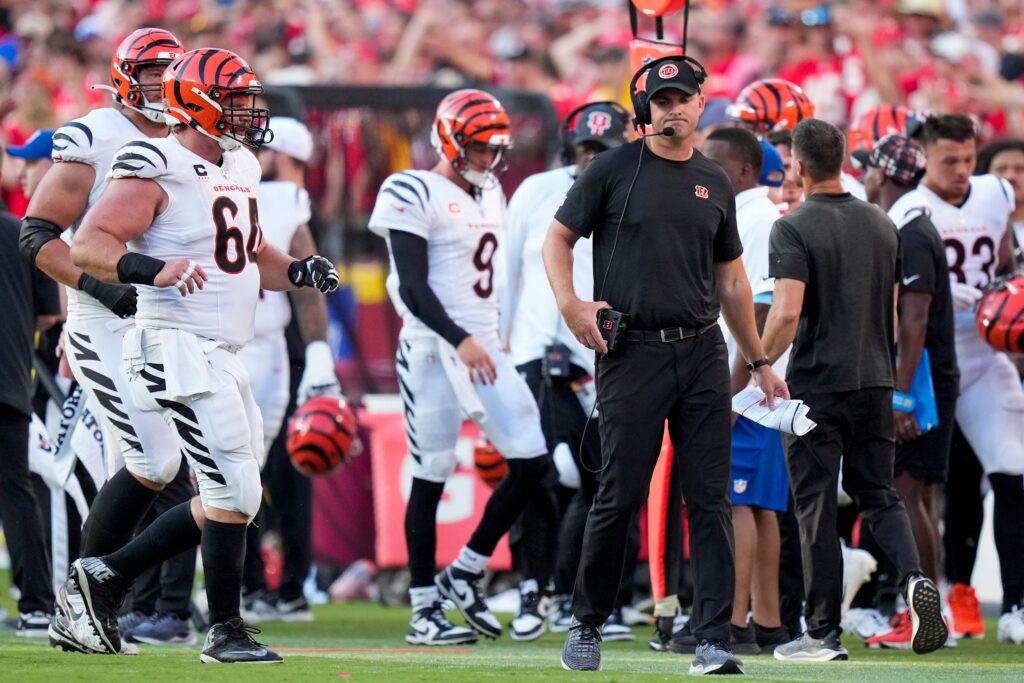
4. The Chiefs Won, But The Bengals Should Feel Ok
There are no moral victories, and it’s never good to start a season 0-2, but the Cincinnati Bengals looked much better in a 26-25 loss to the two-time defending champs than they did last week against the Patriots.
Not only did the Bengals play better, they played differently and mixed things up instead of trying to play the same type of offense while pieces were missing.
Last week, without Tee Higgins and with Ja’Marr Chase not 100 percent, Cincinnati used 11 personnel on 68.8 percent of offensive snaps. Zac Taylor spent time under Sean McVay and an offensive system that bases a lot on three-receiver sets, but the Bengals have often taken that to an extreme. That made sense when the three receivers were Chase, Higgins, and Tyler Boyd, but the Bengals don’t have the same receiver depth as they used to.
With Higgins still out, the Bengals used 11 personnel on 52.5 percent of plays, the second-lowest rate for the team since 2020. Cincinnati also used 12 personnel on 31.5 percent of plays, the highest rate in that time frame. The switch worked, as the Bengals were more successful out of 12 (0.13 EPA per play) than 11 (-0.10).
Cincinnati passed and ran out of the heavier looks, keeping the Chiefs in base defense 37 percent of the time. On those 12 personnel plays, the Bengals used more under center play-action, giving Joe Burrow some time to set up in the pocket and push the ball down the field. He had a 9.9-yard aDOT from 12 and 4.9 from 11.
According to Next Gen Stats, the Bengals also used motion at their highest rate under Zac Taylor (70.5 percent), while they averaged 6.2 yards per play with it and 2.7 yards per play without it.
Of course, a win would have been preferable, especially in such a close game with the Chiefs partially decided by a late penalty when the defense held Patrick Mahomes to a 38.7 percent success rate.
Still, the offense's evolution is a positive takeaway. Cincinnati also gets Washington and Carolina in the next two weeks, so the offense should be completely on track by the time Baltimore visits in Week 5.

5. The Packers Established It
Without Jordan Love, the Green Bay Packers came into their game with the Colts with a plan. That plan was to run the damn ball. The Colts have one of the league's quickest pass rushes, but that aggression off the line can be a negative against the run. In Week 1, the Texans ran all over the Colts, and the Packers followed suit.
In the 16-10 win, Green Bay ran the ball 53 times. That’s the most by a team in a game since the Ravens ran 54 times in Week 17 of 2020. This was one of 35 games since 2000 when a team eclipsed 50 rushing attempts.
On early downs, the Packers threw the ball just 12 percent of the time. That’s the lowest since the 2021 Patriots-Bills game when New England threw the ball just three times in the game — they were also not one of the teams to hit 50 rushing attempts.
The Packers weren’t just going to run it; they had some fun looks to dress everything up. That started on their second offensive play, which had Josh Jacobs and Jayden Reed in the backfield next to Malik Willis.
Willis faked a handoff to Reed before giving the ball to Jacobs. That held linebackers up just enough to let Jacobs run through the line and break through some tackle attempts for a gain of 12.
— Dan Pizzuta (@DanPizzuta) September 16, 2024
The Packers went to this look a few more times, giving Reed the ball twice on run plays — a backward pass and a handoff to Jacobs's side.
— Dan Pizzuta (@DanPizzuta) September 16, 2024
A few plays later, the Packers had a first-and-20 but still handed the ball off to Jacobs and had a perfectly-blocked outside run from shotgun that gained 34 yards.
— Dan Pizzuta (@DanPizzuta) September 16, 2024
In the second quarter, Jacobs had a 16-yard run out of pistol. He was contacted a yard beyond the line of scrimmage but bounced off the defender and got to the outside.
— Dan Pizzuta (@DanPizzuta) September 16, 2024
Almost all of Jacobs’s production came in the first half when the Packers caught the Colts off-guard. By the second half, the Colts just loaded the box and dared the Packers to keep running — and they did. After a 45 percent success rate in the first half with 237 yards, Green Bay had a 5.6 percent rushing success rate in the second half as Indianapolis loaded the box.
That low success rate in the second half kept the Colts in the game longer than they should have been, but the defense forced enough mistakes on the other side of the ball. This won’t be a long-term strategy for however long Love will be out, but it was a useful way to gain an early advantage against a vulnerable opponent.

6. The Bucs flooded the middle of the field
Jared Goff lives in the intermediate middle of the field. Defenses know this, but that doesn’t mean they can stop it. The Tampa Bay Buccaneers did in a 20-16 win to go 2-0 on the season.
On five throws of 11-19 air yards between the numbers, Goff had a 20 percent success rate with two interceptions and -1.67 EPA per play. That was his worst EPA per play during the Ben Johnson era.
Goff threw two interceptions to that part of the field, and it could have been three.
Tampa Bay was all over Goff's middle of the field throws pic.twitter.com/QqmrDSLzVK
— Dan Pizzuta (@DanPizzuta) September 16, 2024
Goff and the Lions threw to the short middle, but even when passes were thrown there, the Buccaneers had defenders ready, and there were not many big gains to be had. Goff's 4.0 yards after the catch per completion were his fourth-lowest with Johnson.

The Buccaneers disrupted the timing of the Lions’ passing offense. Tampa Bay had nine passes defended and 10 quarterback hits. Overall, Goff only averaged 5.6 yards per attempt, which is also the fourth-lowest mark under Johnson.
Tampa Bay blitzed Goff a bunch (36.8 percent on early downs), but the Buccaneers were more effective on plays when they didn’t bring an extra rusher. On a four-man rush, Goff averaged 3.1 air yards per completion and 4.7 yards per attempt with a 40 percent pressure rate. That pressure rate was his seventh-highest of the Ben Johnson era.
Goff handled the pressure in the sense that he didn’t take a sack, but it disrupted how he wanted to play.

7. Should we be concerned about Williams’?
If there was something to worry about with Caleb Williams coming into the NFL, it was the possibility that Chicago’s offensive line would struggle, and Williams would feel the need to make something happen more often than he should. Through two weeks, that’s what we’ve seen.
Against the Texans on Sunday Night Football, a 19-13 loss, Houston's pass rush consistently forced Williams off his spot. The offensive line could not pick up blitzes or stunts, often leaving Williams to flee the pocket.
On throws outside the pocket during the first two weeks, Williams is 1-for-7 with eight scrambles. He has a 14.7-yard aDOT, third in the league behind Josh Allen and Kyler Murray, but just 1.7 yards per attempt. His -0.71 EPA per play ranks 28th and his 20 percent success rate is 29th.
During his final season at USC Williams was wild because he needed to be. His big-play hunting was caused by the offensive structure breaking down and a defense that couldn’t get a stop. He was still prolific at that, ranking 11th in QBR during the 2023 season.
He has the defense that can get stops now, but the offensive structure still leaves something to be desired. There hasn’t been a whole lot of creativity from offensive coordinator Shane Waldron in the first two weeks, and that’s left Williams feeling like he needs to take it open himself to lift the offense. The biggest problem is he hasn’t gotten away with the same things he did in college, as evidenced by a few throws he tried to make on the run Sunday night.
Of course, there were still the flashes we wanted to see. Williams had a nice touchdown drive at the end of the second quarter, but it didn’t last.
Even when things went wrong, the game did look slower to Williams than it did in the Week 1 loss, but he could use some more help by design.
We don’t need to be concerned about Williams, but this is how the worst-case scenario would play out. A three-game stretch of the Colts, Rams, and Panthers could help, and it might have to get his development back on track.
8. Chart of the Day

Geno Smith led the week in passing yards, and he had no right to do so. The Patriots have a good defense. Seattle’s offensive line continued to struggle, and there was no run game to help. Yet, Smith was delivering strikes in the middle of the field.
The Seahawks threw Smith out in empty on 32 percent of his dropbacks, hoping that would be enough to mitigate the struggles in pass protection. Smith found the holes in the New England defense as DK Metcalf and Jaxon Smith-Njigba went for more than 100 yards.
Smith ended with the sixth-highest EPA per play of the day and might have experienced the highest degree of difficulty to get there.
9. Play of the Day
Will Levis is insane. He had another terrible interception that would disqualify most anyone else from ever playing quarterback again, but then he came back with this bomb to Calvin Ridley that somehow wasn’t intercepted.
The Titans still lost, and Levis's success rate was 36.1 percent, tied for the seventh-lowest of the week. But this throw makes you wonder what kind of quarterback Levis could be if he were normal.

10. Brock Bowers Emerging
Brock Bowers had 98 receiving yards, catching all nine of his targets in a 26-23 Raiders win against the Ravens. Through two games, Bowers has 156 yards, the most for a tight end in his first two career games since at least 2000. Only 12 tight ends have hit 100 yards in their first two games.
He’s already a legitimate receiving weapon and was arguably their biggest threat, even on a day when Davante Adams had 100 yards and a touchdown.
Brock Bowers - All Targets from Week 2 at Ravens. Would finish with 9 receptions for 98 yards and a 25% target share pic.twitter.com/pdyC155UwT
— Kyle Lindemann (@LuckIsMadeFF) September 16, 2024
Bowers has lined up all over the field this season. In Week 2, 14.9 percent of his snaps were out wide, 48.8 percent came in the slot, and 36.6 percent were inside. The Raiders lined him up in the backfield for a few snaps in Week 1, too.
Tight end is traditionally a position that takes time to develop. Even as we’ve seen some rookies play well in the past few seasons (Sam LaPorta is in the group above with 102 yards, as was Kyle Pitts at 104), we have not seen a player at this position come in and be so smooth and impactful this early.
Bowers is the type of player and offense that can be built around, and the Raiders would be smart to do so sooner rather than later.

